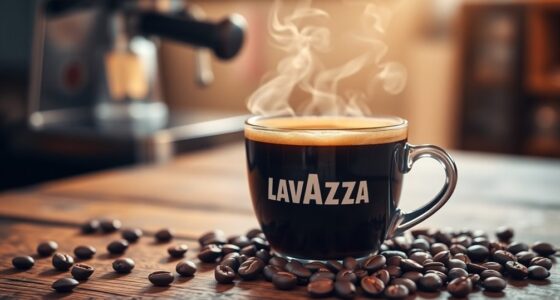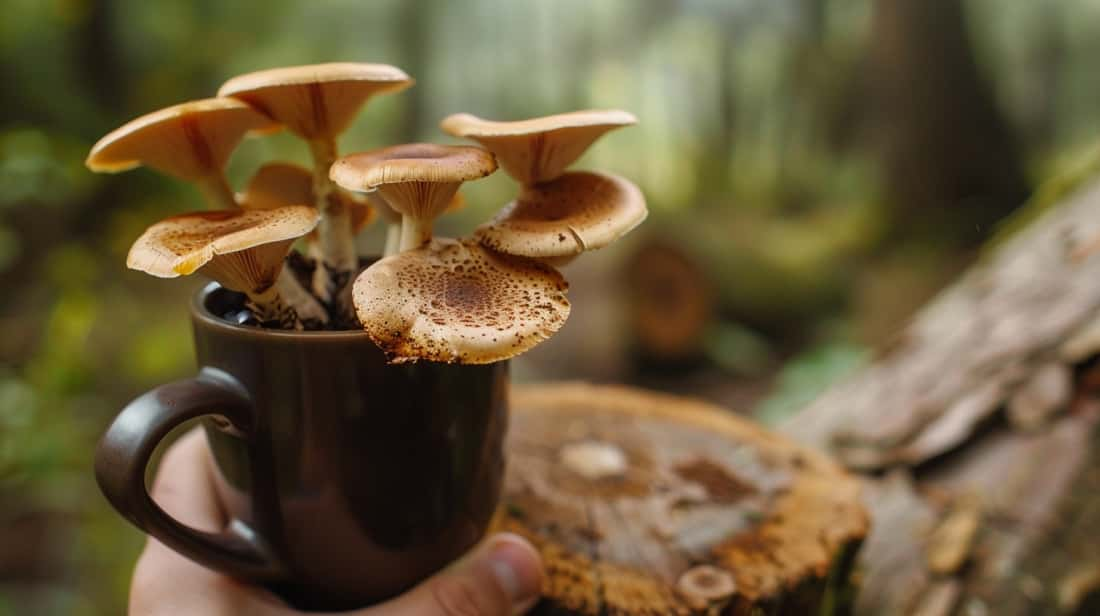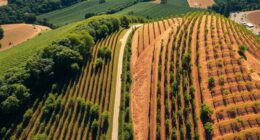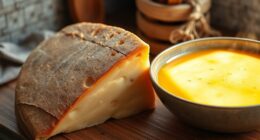Many think espresso and lungo are just different sizes, but they actually have distinct brewing methods, flavors, and origins. Espresso is a concentrated shot made quickly under high pressure, while lungo uses more water for a milder, larger cup. Caffeine levels and taste profiles also differ, with lungo often having a subtler flavor. If you want to discover more about their unique characteristics, keep exploring the differences and nuances.
Key Takeaways
- Espresso is a concentrated, small shot brewed under high pressure, while lungo is a longer, milder coffee with more water.
- Lungo involves a longer extraction, resulting in a larger volume and a different flavor profile compared to espresso.
- Caffeine content is higher in lungo due to increased volume, but both can vary based on beans and brewing parameters.
- Both drinks originate from Italy but differ in brewing techniques, serving size, and taste, not just strength or dilution.
- Misconceptions include that lungo is just weak espresso; in reality, they are distinct with unique brewing processes and flavor nuances.
What Defines an Espresso?
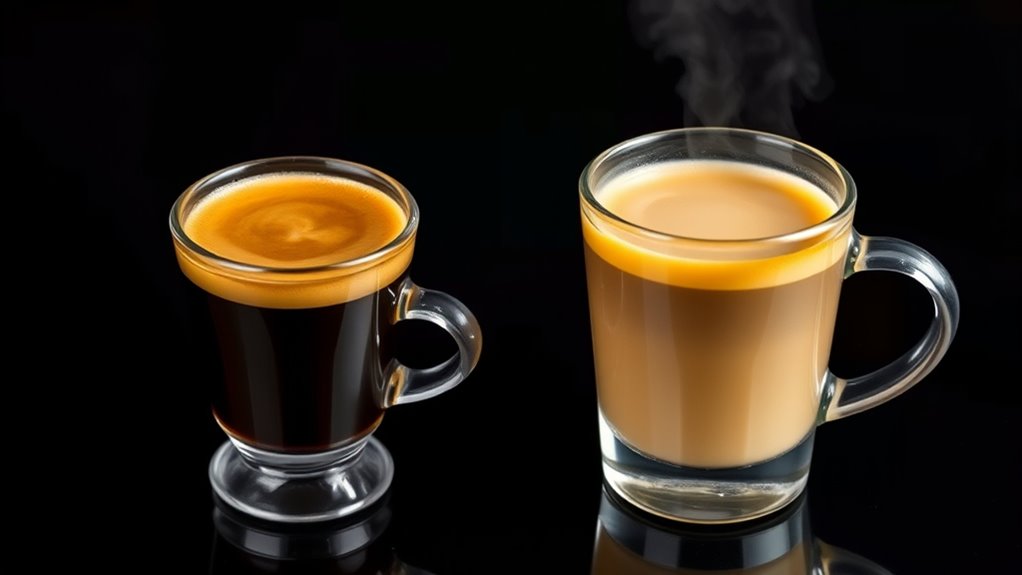
An espresso is a concentrated coffee beverage made by forcing hot water through finely ground coffee beans under high pressure. This brewing technology produces a rich, bold flavor with a distinctive coffee aroma that’s instantly recognizable. The high-pressure extraction pulls out essential oils and flavors, resulting in a thick and creamy crema on top. The precise method of brewing is what sets espresso apart from other coffee types, emphasizing quality and consistency. The aroma released during brewing is intense and inviting, drawing you in with hints of caramel, chocolate, or fruity notes. Because of this meticulous process, espresso delivers a powerful taste experience in a small, concentrated shot, making it the foundation for many coffee drinks worldwide. Additionally, understanding the brewing process can enhance appreciation for the craft behind a perfect espresso.
The Origin of Lungo Coffee
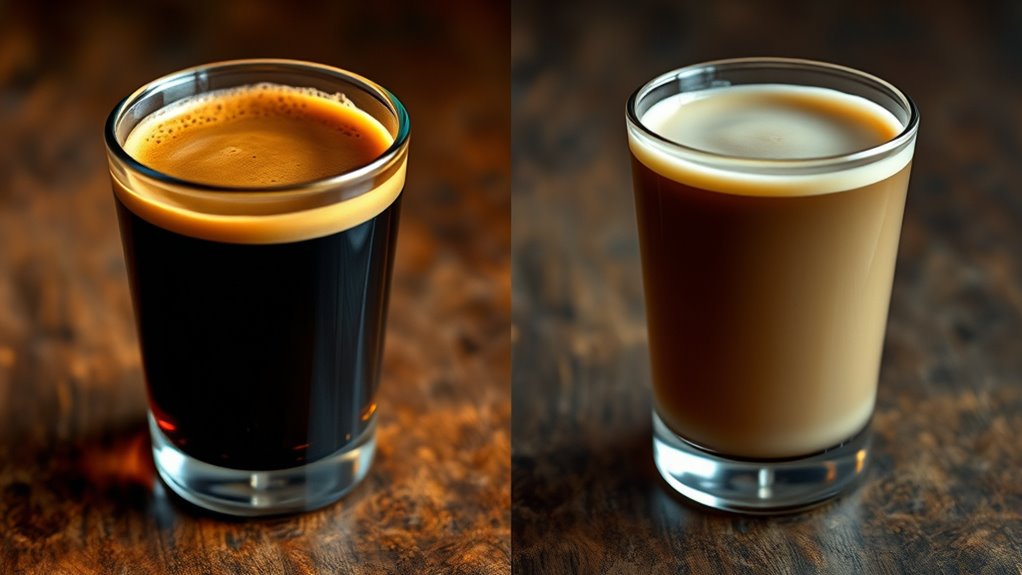
Lungo coffee has roots in Italy’s rich coffee heritage, where brewing techniques evolved over time. It was created to offer a longer, milder espresso experience, reflecting changing tastes. Understanding its history reveals how Italian coffee culture has adapted and expanded. Additionally, the brewing method for lungo involves a longer extraction time, which influences its flavor and strength.
Italian Coffee Heritage
Italy’s rich coffee heritage has shaped the way we enjoy espresso and its variations, including lungo. This tradition dates back centuries, emphasizing quality brewing equipment and craftsmanship. Coffee art, a hallmark of Italian cafes, showcases the skill involved in making a perfect shot, whether short or long. The origin of lungo reflects Italy’s innovative approach, where baristas adapt brewing techniques to create a different experience while maintaining the essence of Italian coffee culture. The precise control of extraction time and water volume highlights the importance of expert equipment and technique. This heritage guarantees every cup honors a centuries-old tradition of excellence, craftsmanship, and passion that continues to influence how you enjoy your coffee today. Understanding brewing techniques is essential to appreciating the nuances that distinguish espresso from lungo.
Evolution of Brewing
The evolution of brewing techniques has led to the creation of the lungo, a coffee variation that offers a different sensory experience from traditional espresso. By extending the extraction process, baristas increased the brewing time, allowing more coffee aroma to develop. This results in a richer, more complex flavor profile. Adjusting the brewing temperature is vital; a slightly lower temperature helps prevent bitterness while maximizing aroma. The lungo’s longer extraction emphasizes subtle notes that are often subdued in espresso. This method originated from the desire to enjoy a larger, more flavorful cup without sacrificing quality. As brewing techniques evolved, so did the lungo, offering coffee lovers a unique way to explore different sensory dimensions within the same brewing style. Additionally, understanding the extraction process is crucial for achieving the desired balance of flavors and avoiding over-extraction that can lead to bitterness.
Brewing Techniques Compared
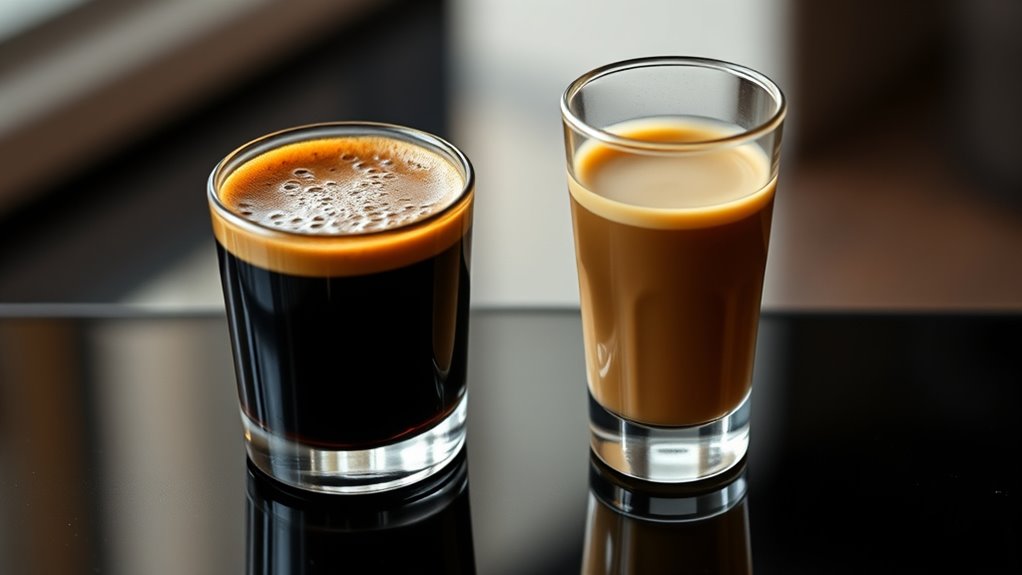
Brewing techniques for espresso and lungo differ primarily in extraction time and pressure, which directly influence flavor and strength. For espresso, you use higher pressure and shorter extraction, resulting in a concentrated shot. Lungo, on the other hand, involves a longer extraction, producing a milder taste and larger volume. To optimize your brew:
- Adjust your machine’s extraction time based on desired strength.
- Pay attention to cup temperature to ensure proper serving.
- Use milk frothing techniques to complement your espresso or lungo.
- Maintain consistent pressure to achieve a balanced flavor profile.
- Incorporating automation technologies in your coffee machine can help maintain consistent parameters and improve brewing precision.
Caffeine Content Differences
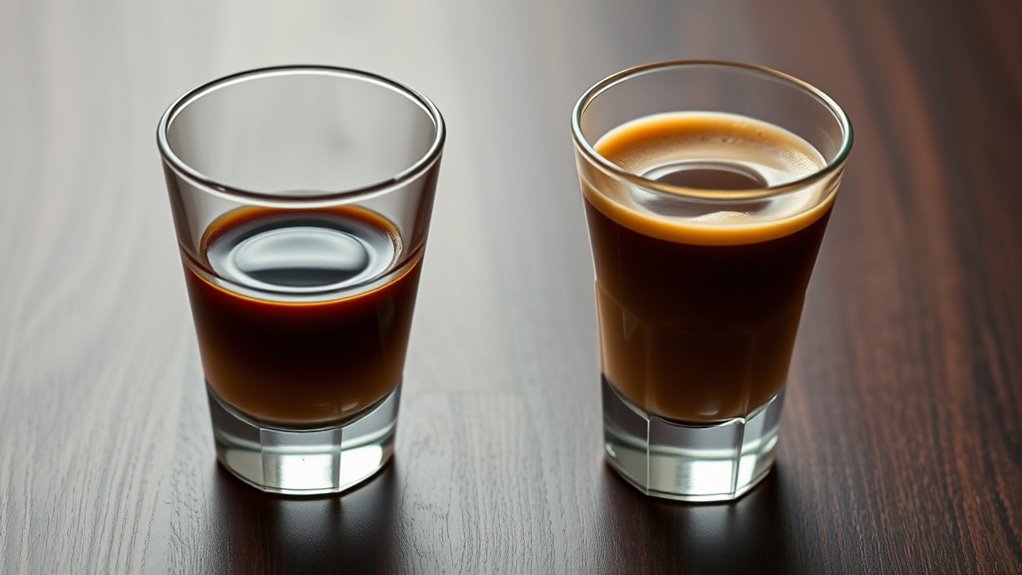
You might assume that a longer coffee like a Lungo automatically has more caffeine than a shot of espresso, but that’s not always the case. While Lungo generally contains more caffeine than a shot of espresso, the actual amount depends on factors like coffee grounds and extraction time. Understanding these differences helps you choose your brew based on your caffeine needs. For example, electric bikes can reach high speeds, but their actual performance depends on the motor power and battery capacity, similar to how caffeine content varies with extraction parameters.
Caffeine Levels in Espresso
While both espresso and lungo are concentrated coffee drinks, their caffeine content can vary considerably depending on how they’re prepared. Generally, a standard shot of espresso contains about 63 mg of caffeine, but this can change based on factors like coffee beans and brewing equipment. For lungo, the caffeine amount can increase because of the larger volume, but not always proportionally. To explore caffeine levels:
- The type of beans used influences caffeine content.
- The grind size affects extraction efficiency.
- Longer extraction times can increase caffeine in both drinks.
- Decaffeinated options are available if you want less caffeine without sacrificing flavor.
- Brewing equipment plays a vital role in controlling caffeine levels, and knowing these factors helps you enjoy your coffee just the way you like it.
Lungo’s Caffeine Increase
Because lungo involves extracting more water through a longer pull, it often results in a higher caffeine content compared to a standard espresso shot. This increased extraction means you’re consuming more dissolved caffeine, which can enhance the stimulant effects you experience. The longer extraction process allows more caffeine to be dissolved from the coffee grounds, leading to a slight increase in caffeine absorption per shot. Additionally, research indicates that caffeine absorption can vary based on individual metabolism and body weight. However, the overall difference isn’t drastic—it’s still less than drinking multiple espresso shots. Your body’s caffeine absorption rate remains consistent, but a lungo’s higher caffeine content can make it feel more energizing. Keep in mind, though, that individual tolerance and metabolism influence how strongly you feel these stimulant effects. So, while lungo may boost your alertness more, moderation is key.
Flavor Profiles and Tasting Notes
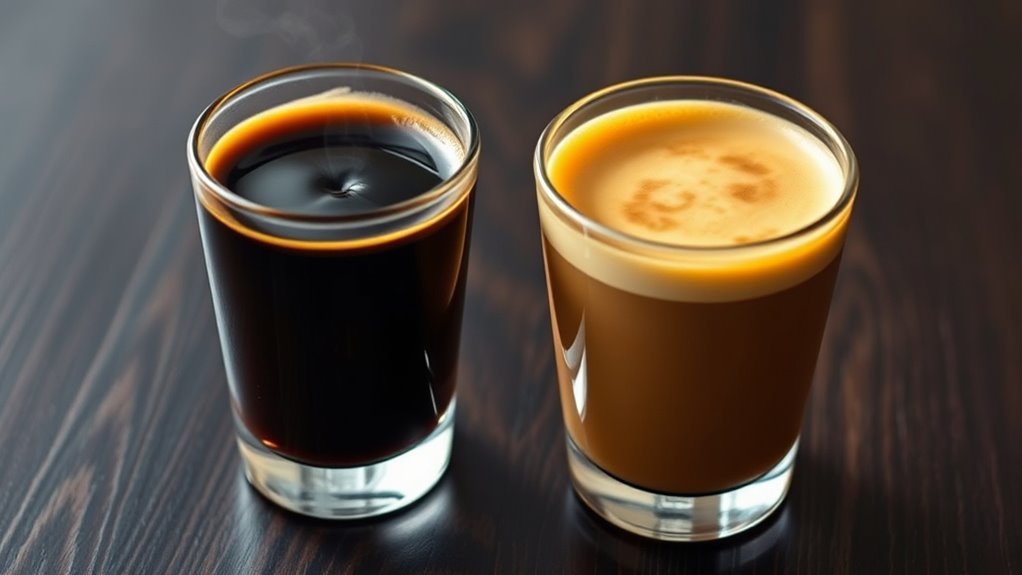
Espresso and lungo offer distinct flavor profiles that cater to different taste preferences. When exploring their tasting notes, you’ll notice subtle flavor nuances that define each. To fully appreciate these differences:
- Savor the bold, intense notes of a well-pulled espresso, often with rich, roasted undertones.
- Detect lighter, more delicate flavors in a lungo, which can include hints of fruit or floral nuances.
- Notice the lingering aftertaste in espresso, highlighting its concentrated flavor.
- Experience the smoother, more balanced profile of a lungo, with less bitterness and a more nuanced complexity.
- Understanding the science behind brewing can help you appreciate how extraction methods influence these unique flavor profiles.
Coffee Bean and Roast Variations
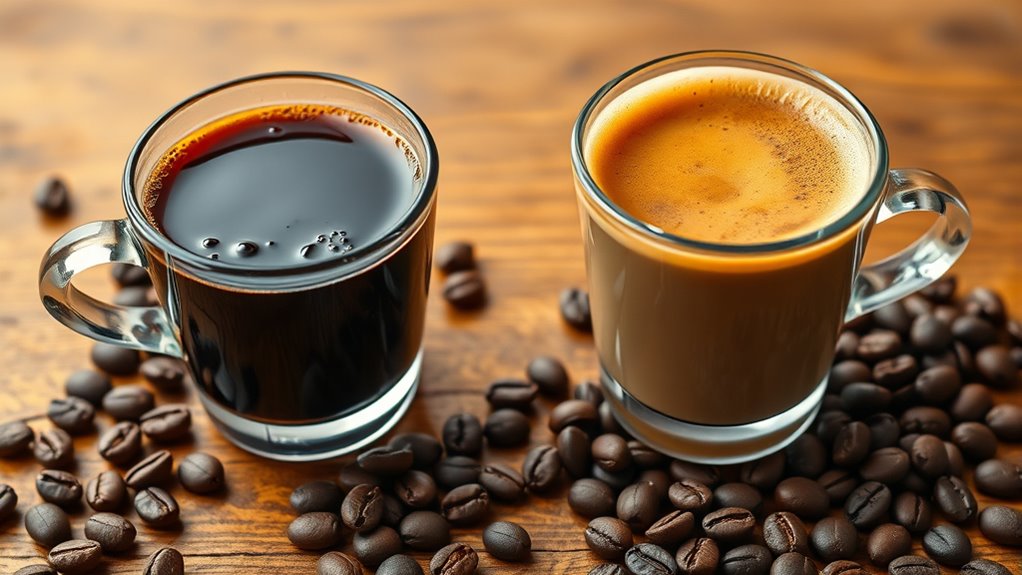
The type of coffee beans and their roast levels greatly influence your brew’s flavor. Different bean origins bring unique tasting notes, while roast levels can enhance or mute those qualities. Understanding these variations helps you choose the right beans for your preferred espresso or lungo. For those interested in a rich, historic ambiance, exploring beans from regions with a storied past can add depth to your coffee experience, much like the preserved historical farmhouses that showcase Alaska’s heritage.
Bean Origin Differences
Different coffee bean origins and roast levels considerably influence the flavor profiles of espresso and lungo. When exploring bean origins, you’ll notice that single origin beans often deliver unique, distinctive notes based on their region. For example, beans from high-altitude farms tend to have brighter acidity and complex flavors due to the altitude impact. Here’s what you should know:
- Single origin beans highlight specific regional flavors.
- Altitude impact enhances acidity and flavor complexity.
- Different regions produce beans with distinct profiles—Africas offer bright, fruity notes; South Americans provide nutty, chocolate tones.
- Roast levels can accentuate regional traits, but the origin largely determines the base flavor.
Understanding bean origin differences helps you appreciate how altitude and regional characteristics shape your espresso or lungo experience.
Roast Level Impacts
Roast level plays an essential role in shaping the flavor profile of your espresso or lungo, as it influences the beans’ aroma, acidity, and body. Lighter roasts tend to be more acidic with brighter flavors, while darker roasts develop richer, bolder notes. The roast level also affects your grind size; darker roasts require a slightly coarser grind, whereas lighter roasts need a finer one for ideal extraction. Additionally, the roasting degree impacts brewing temperature; darker roasts extract better at higher temperatures, making them more forgiving during brewing. Conversely, lighter roasts demand precise temperature control to prevent under-extraction. Adjusting grind size and brewing temperature based on roast level ensures you maximize flavor, whether you prefer a sharp, lively espresso or a smooth, mellow lungo.
Flavor Profiles Variations
Flavor profiles in coffee vary considerably depending on both the bean origin and roast level, which together shape the taste experience. You’ll notice that different beans bring unique qualities, from fruity to nutty notes, while roast levels influence whether those flavors become bold or subtle. Additionally, brewing equipment can highlight or mute certain flavors, especially when using artificial flavorings or advanced machines. To explore these variations:
- Choose beans from different regions to experience diverse flavor nuances.
- Adjust roast levels to see how light, medium, or dark roasts alter taste.
- Use various brewing equipment to extract different flavor profiles.
- Be cautious with artificial flavorings—they can overshadow natural bean characteristics.
Serving Size and Presentation
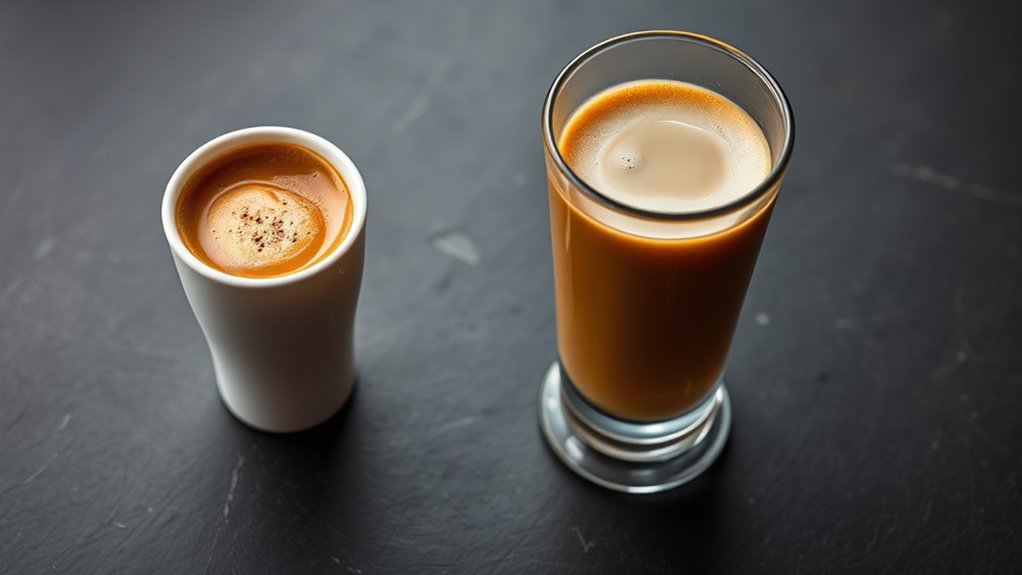
While espresso and lungo both deliver rich, concentrated coffee, their serving sizes and presentation styles differ markedly. An espresso typically comes in a small, 1 to 2-ounce shot, emphasizing intensity and a thick crema. Its presentation style is minimalist, often served in a small cup to highlight its bold flavor. In contrast, a lungo has a larger serving size, usually around 3 to 4 ounces, with more water used during extraction. Its presentation style might involve a slightly larger cup, showcasing a more diluted, milder flavor profile. The difference in serving size influences the overall experience: espresso offers a quick, intense taste, while lungo provides a longer, more subdued sip. Knowing these distinctions helps you appreciate the unique appeal of each coffee.
Common Misconceptions About Espresso and Lungo
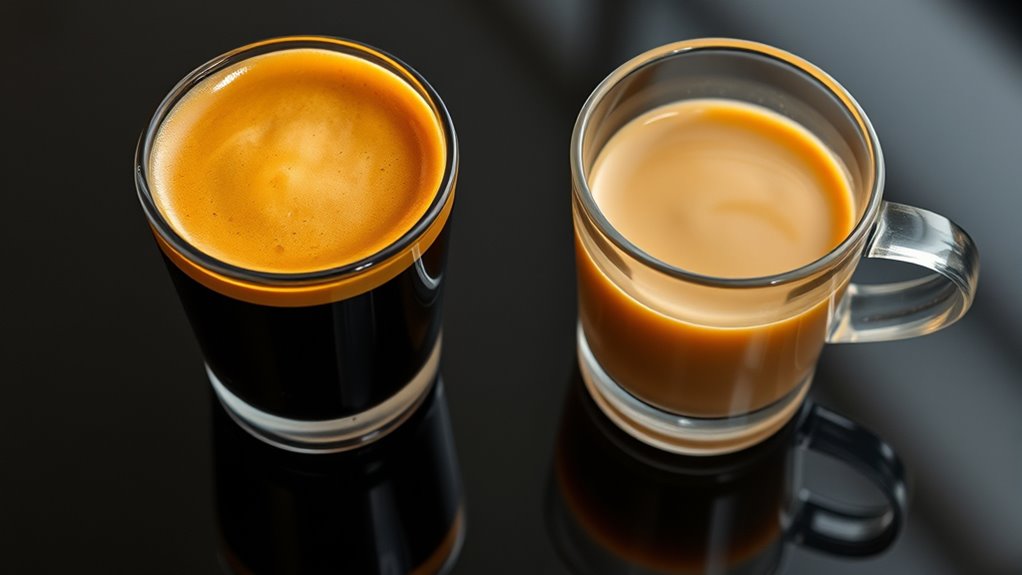
Many people assume that espresso and lungo are simply variations of the same coffee, but this isn’t accurate. A common misconception is that longer extraction means weaker flavor, but in reality, lungo involves different brewing parameters. Here’s what you should know:
- The extraction time varies—lungo usually takes longer, affecting cup temperature.
- Milk frothing techniques differ because a longer shot can cool faster, impacting texture.
- The size of the cup influences how hot your coffee stays; larger cups may require pre-warming.
- The taste profile isn’t just diluted; lungo often emphasizes different flavors due to brewing differences.
Understanding these nuances helps you appreciate each style beyond misconceptions, especially when considering factors like cup temperature and proper milk frothing.
Health Implications of Each Style

Both espresso and lungo can impact your health in different ways due to their varying caffeine content and brewing methods. Caffeine absorption occurs quickly, so drinking a lungo might lead to a more prolonged stimulant effect because of its larger volume. This can influence your blood pressure, especially if you’re sensitive to caffeine or consume multiple cups daily. Increased caffeine intake may cause temporary spikes in blood pressure and heart rate, which could be risky for those with hypertension or cardiovascular concerns. However, moderate consumption of either style generally has minimal health risks. It’s vital to be mindful of your body’s response to caffeine and adjust your intake accordingly. Being aware of these factors helps you enjoy your coffee while managing potential health implications.
How to Choose Between Espresso and Lungo
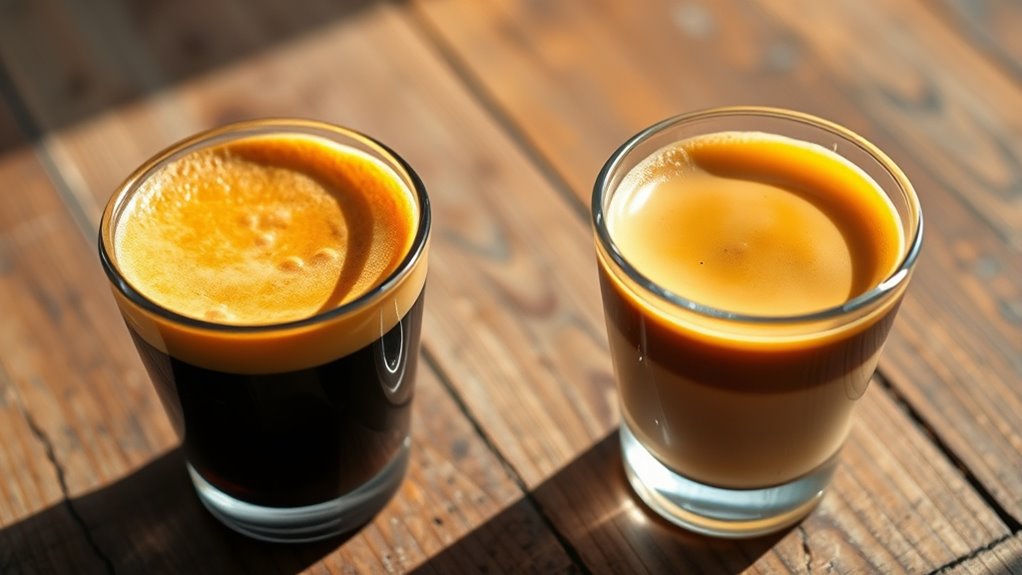
Choosing between espresso and lungo depends on your taste preferences, caffeine needs, and how you like your coffee to feel. If you want a stronger caffeine potency and a bold flavor, espresso is your go-to. For a milder taste with a larger volume, lungo offers a smoother experience. Consider serving aesthetics: espresso’s compact shot looks intense, while lungo’s larger cup appears more inviting. To help decide:
- Think about caffeine strength—espresso packs more per ounce.
- Match your flavor preference—bold versus mellow.
- Assess your serving aesthetics—small shot or extended brew.
- Decide on the volume—quick shot or a longer sip.
Your choice ultimately hinges on whether you prioritize caffeine punch, visual appeal, or drinking experience.
Frequently Asked Questions
Which Method Preserves More Nutritional Compounds in the Coffee?
You want to know which method preserves more nutritional compounds in coffee. During coffee extraction, a lungo typically involves longer brewing, which can extract more nutrients from the coffee grounds, enhancing nutrient retention. Espresso, with its quick extraction, may retain fewer nutrients but offers a concentrated flavor. So, if nutrient preservation is your goal, lungo’s method generally allows for better extraction of beneficial compounds.
Can You Customize the Strength of an Espresso or Lungo?
Yes, you can customize the strength of an espresso or lungo by adjusting brew temperature and grind size. For a stronger shot, use a finer grind and slightly higher brew temperature, which extracts more flavors and compounds. If you want a milder taste, opt for a coarser grind and lower temperature. Experimenting with these settings lets you tailor your coffee’s strength to your preference, ensuring a perfect cup every time.
Do Different Cup Materials Affect the Coffee’s Flavor?
Yes, different cup materials can affect your coffee’s flavor influence. For example, ceramic cups tend to retain heat well, preserving the aroma and warmth, while metal cups might cool your coffee faster, slightly altering the taste experience. Glass cups let you see the coffee’s color but may not retain heat as effectively. So, choosing the right cup material enhances your overall coffee enjoyment by subtly influencing flavor and temperature.
How Do Regional Preferences Influence Espresso and Lungo Styles?
Think of regional preferences as a map guiding your coffee journey. You’ll find that cultural variations shape how espresso and lungo are crafted and enjoyed, like a local dialect influencing a story. In Italy, espresso’s strong and quick, while in Japan, lungo might be appreciated for its smoothness. Your taste is a reflection of these regional tastes, blending tradition and personal preference into every sip.
Are There Sustainable Practices Specific to Brewing Espresso or Lungo?
You can practice sustainable brewing by choosing espresso and lungo methods that prioritize sustainable sourcing for your coffee beans. Using eco-friendly equipment, like energy-efficient espresso machines and reusable filters, also helps reduce your environmental impact. By supporting brands committed to ethical sourcing and environmentally friendly practices, you guarantee your coffee routine is more sustainable. This way, you enjoy your favorite drinks while contributing to a healthier planet.
Conclusion
Now that you know the differences between espresso and lungo, which one will you choose for your next coffee break? Whether you prefer the bold intensity of an espresso or the milder, longer sip of a lungo, it all depends on your taste and mood. So, next time you order, ask yourself: are you craving a quick, concentrated shot or a more relaxed, extended brew? Your perfect cup awaits—what’s your pick?


